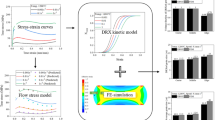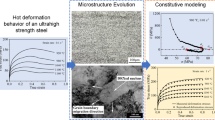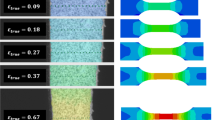Abstract
Ultra-high strain rate deformation (> 104 s−1) is common in high speed manufacturing and impact engineering. However, a general constitutive model suitable for describing the material deformation at ultra-high strain rates is still unavailable. The purpose of this study is of two-folds. The first is to systematically evaluate the performances of four typical constitutive models, Johnson-Cook (J-C), Khan-Huang-Liang (KHL), Zerilli-Armstrong (Z-A), and Gao-Zhang (G-Z), in predicting the dynamic behaviors of materials. The second is to obtain an improved constitutive model to better describe the deformation of materials under ultra-high strain rates. To this end, high strain rate tests were carried out on different crystalline structures, i.e., BCC, FCC, and HCP over a wide range of strain rate from 102 s−1 to 1.5 × 104 s−1. It was found that before the critical strain rate, around 104 s−1, all of the previous models can predict the flow stresses. When the strain rate passes a critical point, however, these models fail to predict the sudden upsurge of the flow stresses. The improved model developed in this paper, by considering the dislocation drag mechanism, can successfully characterize the dynamic behaviours of materials over the whole range of strain rates.
Similar content being viewed by others
References
Abed, F. H. and Voyiadjis, G. Z. (2005). A consistent modified Zerilli-Armstrong flow stress model for BCC and FCC metals for elevated temperatures. Acta Mechanica 175, 1–4, 1–18.
Aziz, A. (2012). Characterising the Effective Material Softening in Ultrasonic Forming of Metals. Ph. D. Dissertation. University of Glasgow. Glasgow, UK.
Beusink, M. (2011). Measurements and Simulations on the (Dynamic) Properties of Aluminium Alloy AA6060. Ph. D. Dissertation. Eindhoven University of Technology. Eindhoven, The Netherlands.
Bobbili, R. and Madhu, V. (2016). Effect of strain rate and stress triaxiality on tensile behavior of Titanium alloy Ti-10-2-3 at elevated temperatures. Materials Science and Engineering: A, 667, 33–41.
Daud, Y., Lucas, M. and Huang, Z. (2007). Modelling the effects of superimposed ultrasonic vibrations on tension and compression tests of aluminium. J. Materials Processing Technology 186, 1–3, 179–190.
Follansbee, P. and Weertman, J. (1982). On the question of flow stress at high strain rates controlled by dislocation viscous flow. Mechanics of Materials 1, 4, 345–350.
Gao, C., Lu, W., Zhang, L. C. and Yan, H. (2012). A constitutive description of the thermo-viscoplastic behavior of body-centered cubic metals. Materials & Design (1980–2015), 36, 671–678.
Gao, C. and Zhang, L. C. (2010). A constitutive model for dynamic plasticity of FCC metals. Materials Science and Engineering: A 527, 13–14, 3138–3143.
Gao, C. and Zhang, L. C. (2012). Constitutive modelling of plasticity of fcc metals under extremely high strain rates. Int. J. Plasticity, 32–33, 121–133.
Gao, C., Zhang, L. C. and Yan, H. (2011). A new constitutive model for HCP metals. Materials Science and Engineering: A 528, 13–14, 4445–4452.
Johnson, G. R. and Cook, W. H. (1983). A constitutive model and data for metals subjected to large strains, high strain rates and high temperatures. Proc. 7th Int. Symp. Ballistics. The Hague, The Netherlands, 541–547.
Khan, A. S., Baig, M., Choi, S.-H., Yang, H.-S. and Sun, X. (2012). Quasi-static and dynamic responses of advanced high strength steels: Experiments and modeling. Int. J. Plasticity, 30–31, 1–17.
Khan, A. S. and Huang, S. (1992). Experimental and theoretical study of mechanical behavior of 1100 aluminum in the strain rate range 10−5–104 s−1. Int. J. Plasticity 8, 4, 397–424.
Khan, A. S., Suh, Y. S. and Kazmi, R. (2004). Quasi-static and dynamic loading responses and constitutive modeling of titanium alloys. Int. J. Plasticity 20, 12, 2233–2248.
Kumar, A., Hauser, F. and Dorn, J. (1968). Viscous drag on dislocations in aluminum at high strain rates. Acta Metallurgica 16, 9, 1189–1197.
Lin, Y. and Chen, X.-M. (2011). A critical review of experimental results and constitutive descriptions for metals and alloys in hot working. Materials & Design 32, 4, 1733–1759.
Lu, X. and Khonsari, M. (2007). An experimental investigation of dimple effect on the stribeck curve of journal bearings. Tribology Letters, 27, 169.
Luo, B., Li, M., Wang, G., Tan, F., Zhao, J. and Sun, C. (2017). Strain rate and hydrostatic pressure effects on strength of iron. Mechanics of Materials, 114, 142–146.
Meyer Jr, H. W. (2006). A Modified Zerilli-Armstrong Constitutive Model Describing the Strength and Localizing Behavior of Ti-6A1-4V. DTIC Document.
Mirone, G., Corallo, D. and Barbagallo, R. (2016). Interaction of strain rate and necking on the stress-strain response of uniaxial tension tests by Hopkinson bar. Procedia Structural Integrity, 2, 974–985.
Patel, J. and Chaudhuri, A. (1963). Macroscopic plastic properties of dislocation-free germanium and other semiconductor crystals. I. Yield behavior. J. Applied Physics 34, 9, 2788–2799.
Ramesh, K. T. (2008). High Rates and Impact Experiments. Springer Handbook of Experimental Solid Mechanics. Springer, 929–960.
Regazzoni, G., Kocks, U. and Follansbee, P. S. (1987). Dislocation kinetics at high strain rates. Acta Metallurgica 35, 12, 2865–2875.
Song, B., Chen, W., Antoun, B. and Frew, D. (2007). Determination of early flow stress for ductile specimens at high strain rates by using a SHPB. Experimental Mechanics 47, 5, 671–679.
Verleysen, P. and Peirs, J. (2017). Quasi-static and high strain rate fracture behaviour of Ti6Al4V. Int. J. Impact Engineering, 108, 370–388.
Wedberg, D. and Lindgren, L.-E. (2015). Modelling flow stress of AISI 316L at high strain rates. Mechanics of Materials 91, Part 1, 194–207.
Xu, W., Sedaghat, H. and Zhang, L. C. (2018). On the deformation behaviour of some metals under high strain rate and high frequency impact. Proc. AEPA2018, Jeju, Korea.
Zaretsky, E. and Kanel, G. I. (2012). Effect of temperature, strain, and strain rate on the flow stress of aluminum under shock-wave compression. J. Applied Physics 112, 7, 073504.
Zerilli, F. J. and Armstrong, R. W. (1987). Dislocation-mechanics-based constitutive relations for material dynamics calculations. J. Applied Physics 61, 5, 1816–1825.
Acknowledgement
This research was financially supported by an ARC Discovery Project (DP170100567) and was undertaken with the assistance of resources provided at the NCI National Facility systems at the Australian National University and Intersect Australia Ltd.
Author information
Authors and Affiliations
Corresponding author
Additional information
Publisher’s Note
Springer Nature remains neutral with regard to jurisdictional claims in published maps and institutional affiliations.
This paper was significantly extended and modified from the original paper presented in Asia-Pacific Symposium on Engineering Plasticity and its Applications 2018, and recommended by the Scientific & Technical Committee for journal publication.
Rights and permissions
About this article
Cite this article
Sedaghat, H., Xu, W., Zhang, L. et al. On the Constitutive Models for Ultra-High Strain Rate Deformation of Metals. Int.J Automot. Technol. 20 (Suppl 1), 31–37 (2019). https://doi.org/10.1007/s12239-019-0125-5
Received:
Revised:
Accepted:
Published:
Issue Date:
DOI: https://doi.org/10.1007/s12239-019-0125-5




